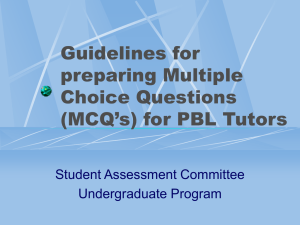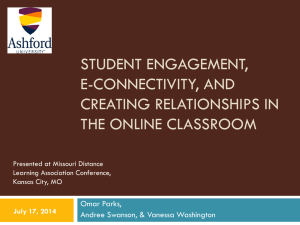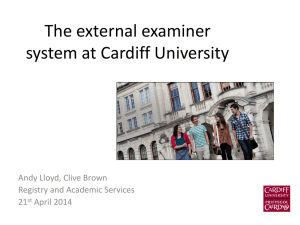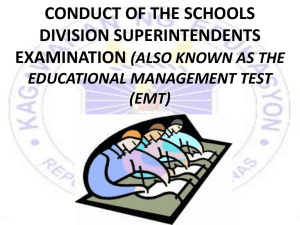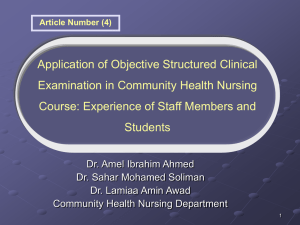Test Taking Skills
advertisement
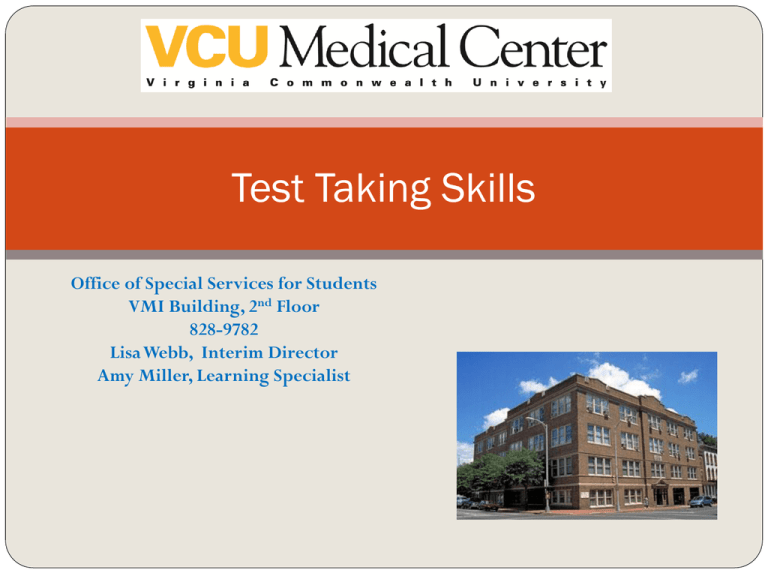
Test Taking Skills Office of Special Services for Students VMI Building, 2nd Floor 828-9782 Lisa Webb, Interim Director Amy Miller, Learning Specialist Oh Yeah! Syndrome The Problem: Students who have covered some of the same topics, and therefore do not pay attention to re-learning the information. Example: “The Cell Cycle, Mitosis and Meiosis” – a fundamental principle of biology. The assumption of the student is: “I already know the steps of the cell cycle and the major differences between mitosis and meiosis.” Treatment: You need to learn the material to the depth of understanding required by your instructors in the School of Medicine, which is different than what was required by your undergraduate professors. “Oh Yeah!” becomes “Oh NO!” very quickly! Burns, E. R. (2006). Learning syndromes afflicting beginning medical students: identification and treatment reflections after forty years of teaching. Medical Teacher , 230 - 233. Testwiseness for Multiple Choice Exams Grammatical cues - one or more distracters don’t follow grammatically from the stem Logical cues - a subset of the options is collectively exhaustive Absolute terms - terms such as “always” or “never” are in some options Long correct answer - correct answer is longer, more specific, or more complete than other options Word repeats - a word or phrase is included in the stem and in the correct answer Convergence strategy - the correct answer includes the most elements in common with the other options Case, Susan; Swanson, David. (2001). ConstructingWritten Test Questions. Philadelphia: National Board of Medical Examiners. Testwiseness: Grammatical Errors A 60-year-old man is brought to the emergency department by the police, who found him lying unconscious on the sidewalk. After ascertaining that the airway is open, the first step in management should be intravenous administration of A. examination of cerebrospinal fluid B. x-rays C. CT scan of the head D. phenytoin E. diazepam Case, Susan; Swanson, David. (2001). ConstructingWritten Test Questions. Philadelphia: National Board of Medical Examiners. Grammatical Errors Explanation In this example, test wise students would eliminate A and C as options because they do not follow grammatically or logically from the stem. Test wise students then have to choose only between B, D, and E. Case, Susan; Swanson, David. (2001). ConstructingWritten Test Questions. Philadelphia: National Board of Medical Examiners. Testwiseness: Logical Cues Crime is A. equally distributed among the social classes B. overrepresented among the poor C. overrepresented among the middle class and rich D. primarily an indication of psychosexual maladjustment E. reaching a plateau of tolerability for the nation Case, Susan; Swanson, David. (2001). ConstructingWritten Test Questions. Philadelphia: National Board of Medical Examiners. Logical Cues Explanation In this item, Options A, B, and C include all possibilities. The test wise student knows that A, B, or C must be correct, whereas the non-test wise student spends time considering D and E. Often D and E are only there because 5 options are needed. This flaw is commonly seen when the options are “increases”, “decreases” and/or “remains the same”. Case, Susan; Swanson, David. (2001). ConstructingWritten Test Questions. Philadelphia: National Board of Medical Examiners. Testwiseness: Absolute Terms In patients with advanced dementia, Alzheimer’s type, the memory defect A. can be treated adequately with phosphatidylcholine (lecithin) B. could be a sequela of early parkinsonism C. is never seen in patients with neurofibrillary tangles at autopsy D. is never severe E. possibly involves the cholinergic system Case, Susan; Swanson, David. (2001). ConstructingWritten Test Questions. Philadelphia: National Board of Medical Examiners. Absolute Terms Explanation In this item, Options A, B, and E contain terms that are less absolute than those in Options C and D. The test wise student will eliminate Options C and D as possibilities because they are less likely to be true than something stated less absolutely. Case, Susan; Swanson, David. (2001). ConstructingWritten Test Questions. Philadelphia: National Board of Medical Examiners. Testwiseness: Long Correct Answer Secondary gain is A. synonymous with malingering B. a frequent problem in obsessive-compulsive disorder C. a complication of a variety of illnesses and tends to prolong many of them D. never seen in organic brain damage Case, Susan; Swanson, David. (2001). ConstructingWritten Test Questions. Philadelphia: National Board of Medical Examiners. Long Correct Answer Explanation In this item, Option C is longer than the other options; it is also the only double option. Case, Susan; Swanson, David. (2001). ConstructingWritten Test Questions. Philadelphia: National Board of Medical Examiners. Testwiseness: Word Repeat A 58-year-old man with a history of heavy alcohol use and previous psychiatric hospitalization is confused and agitated. He speaks of experiencing the world as unreal.This symptom is called A. depersonalization B. derailment C. derealization D. focal memory deficit E. signal anxiety Case, Susan; Swanson, David. (2001). ConstructingWritten Test Questions. Philadelphia: National Board of Medical Examiners. Word Repeat Explanation This is when a work or phrase is used in the question and the correct answer. This item uses the word “unreal” in the stem, and “derealization” is the correct answer. Case, Susan; Swanson, David. (2001). ConstructingWritten Test Questions. Philadelphia: National Board of Medical Examiners. Testwiseness: Convergence Local anesthetics are most effective in the A. anionic form, acting from inside the nerve membrane B. cationic form, acting from inside the nerve membrane C. cationic form, acting from outside the nerve membrane D. uncharged form, acting from inside the nerve membrane E. uncharged form, acting from outside the nerve membrane Case, Susan; Swanson, David. (2001). ConstructingWritten Test Questions. Philadelphia: National Board of Medical Examiners. Convergence Explanation In this example, the test wise student would eliminate “anionic form” as unlikely because “anionic form” appears only once; that student would also exclude “outside the nerve membrane” because “outside” appears less frequently than “inside”. The student would then have to decide between Options B and D. Since three of the five options involve a charge; the test wise student would then pick Option B. Case, Susan; Swanson, David. (2001). ConstructingWritten Test Questions. Philadelphia: National Board of Medical Examiners. Essay and Open Book Exams Essay Be concise Don’t attempt to write down everything you know Make an outline Open book/open notes Study the material Mark with sticky notes, highlighting, color coding, or other markers those sections of your textbook or notes that might address different potential questions. Clearly label the markers with specific descriptions, so those sections can be found easily during the exam. Make lists of important facts and other details, so this information will be readily available as you need it during the exam. True/False Questions Pay close attention to key words on True-False Tests. a. Closed words (such as never, only, always, all, none, and most) are often (but not always) indicators of a false statement because they restrict possibilities. b. Open words (such as usually, frequently, mostly, may, and generally) are often (but not always) found in true statements. If any part of the question is false, then the entire statement is false BUT just because part of a statement is true doesn't necessarily make the entire statement true. Preparing For Multiple Tests As soon as you have the syllabus for each class write the dates of important tests, projects, and papers so they don’t sneak up on you Break up the work so it doesn’t get boring and strenuous Set up a schedule of alternating times and locations to work/study Classify your exams in order of difficulty Spread studying for difficult exams over the span of a few days. Try and reward yourself at the end of each day for accomplishing your goal. i.e. Dinner out or movie with a friend Decide which subject needs more attention and focus more time on that one TAKE BREAKS IN BETWEEN TOPICS Leave yourself a few days of “wiggle room” before something is due so you can tweak it to perfection, or if things just pile up too much, you won’t feel so pressed for time and end up doing a sub-par job Simple Reminders Make a study plan and STICK TO IT. DO NOT change your answers DO NOT read into the questions Read the entire question and all potential answers first before answering it If practice exams are available USE THEM (pay attention to your time if you are using these practice tests) Use your time effectively and efficiently Oral review Quiz one another and clarify information Use group learning opportunities Test yourself on what you have learned Simple Reminders (continued) Look for a variety of creative ways to interact with the information you are trying to learn Participate actively in a study group Use tools - flash cards, sticky notes, tape recorder Create mnemonics in order to memorize key points or steps Explain the main points of the chapter to someone else (a family member, friend, or roommate) Create tables, graphs, or diagrams to illustrate difficult concepts Read your summary of the chapter (or notes) aloud, record it, play it back and listen to it Simple Reminders (continued) Do not procrastinate Rewrite information in your own words Underline the ey words in questions If you don’t know the answer, mark the answer that you think is the best answer and move on. GO back to the questions that you weren’t sure of at the end of the test if time permits Eliminate answers as quickly as possible to narrow down your choices Do NOT compare yourself to others Trust yourself and what you know The Things You Will Ignore, But Will Help You Improve Your Test Taking Skills! •Get Enough Sleep •Eat Balanced Meals •Pay Attention to Your Physical and Mental Health •Don’t Wait to Ask for Help! Special Services for Students For More Information Please contact Lisa Webb, lbwebb@vcu.edu or Amy Miller, ammiller4@vcu.edu 804-828-9782
